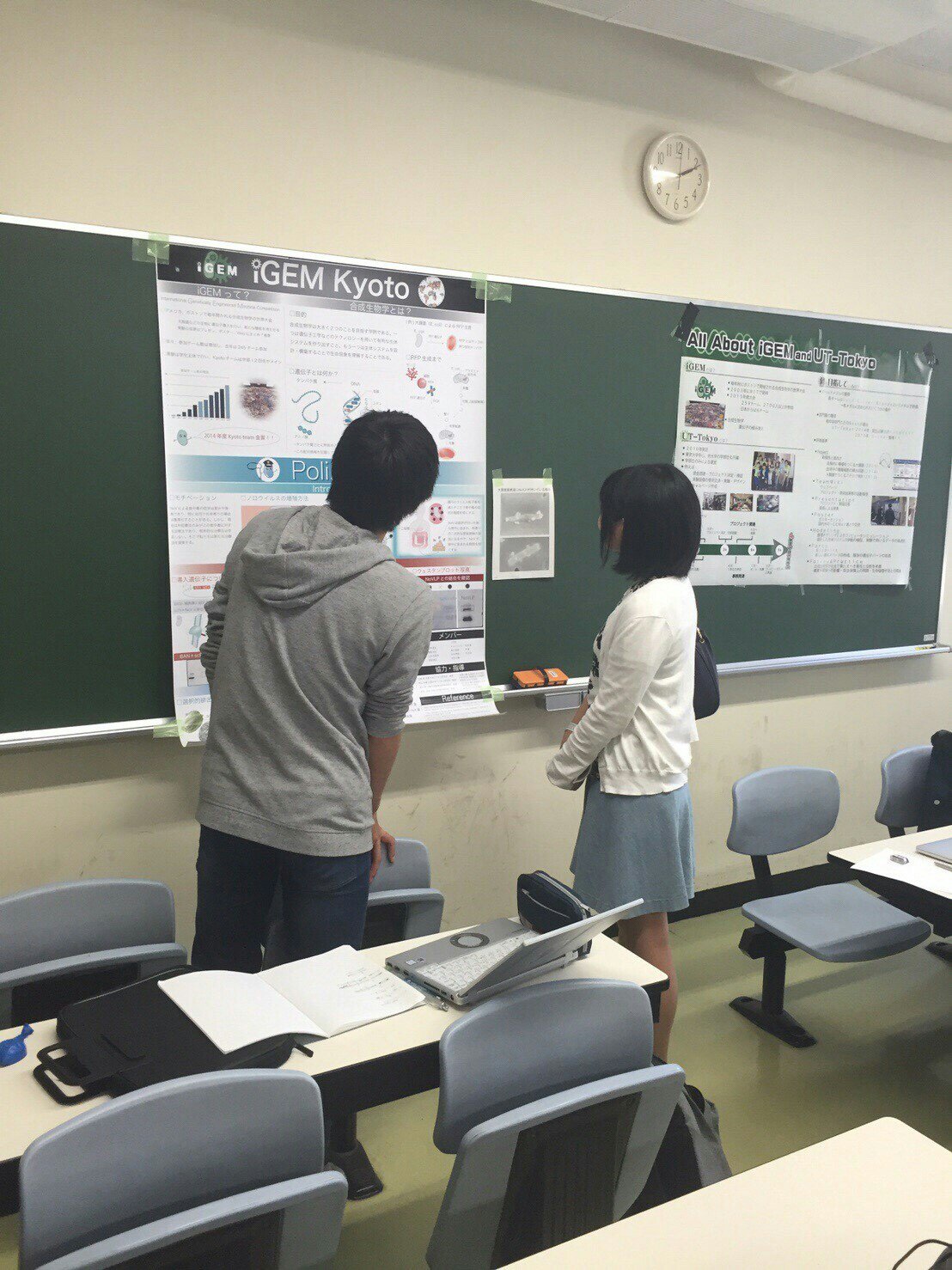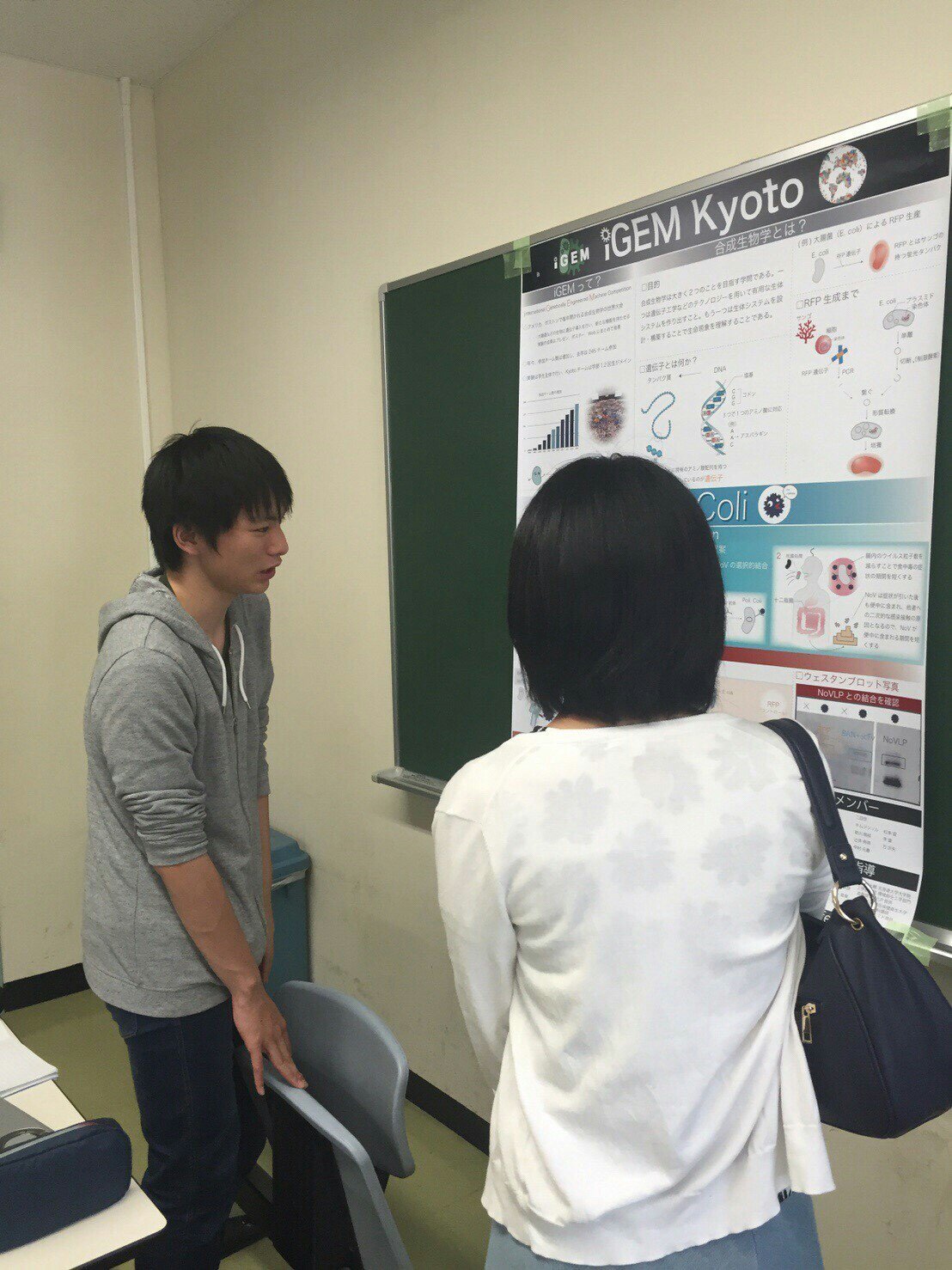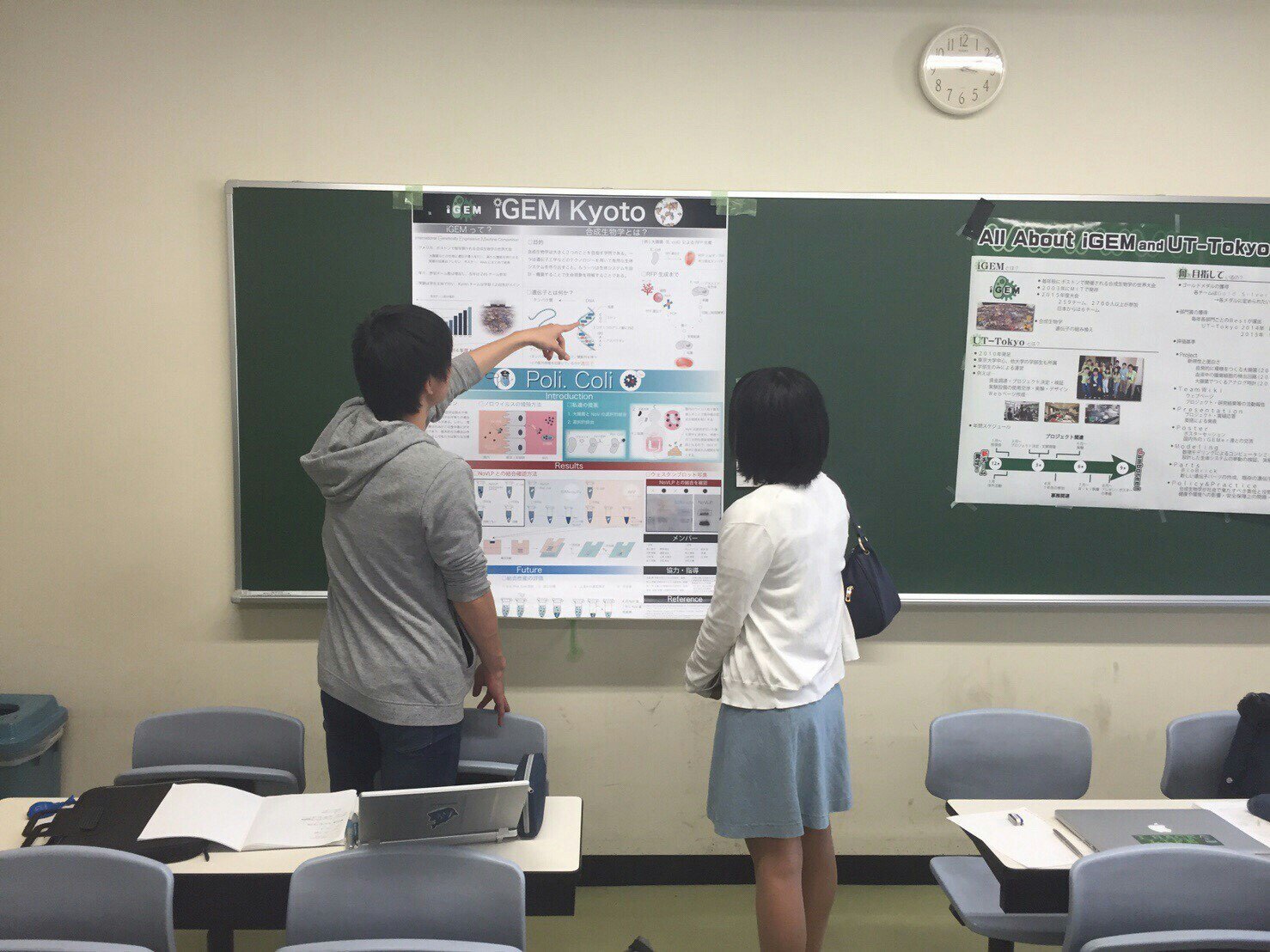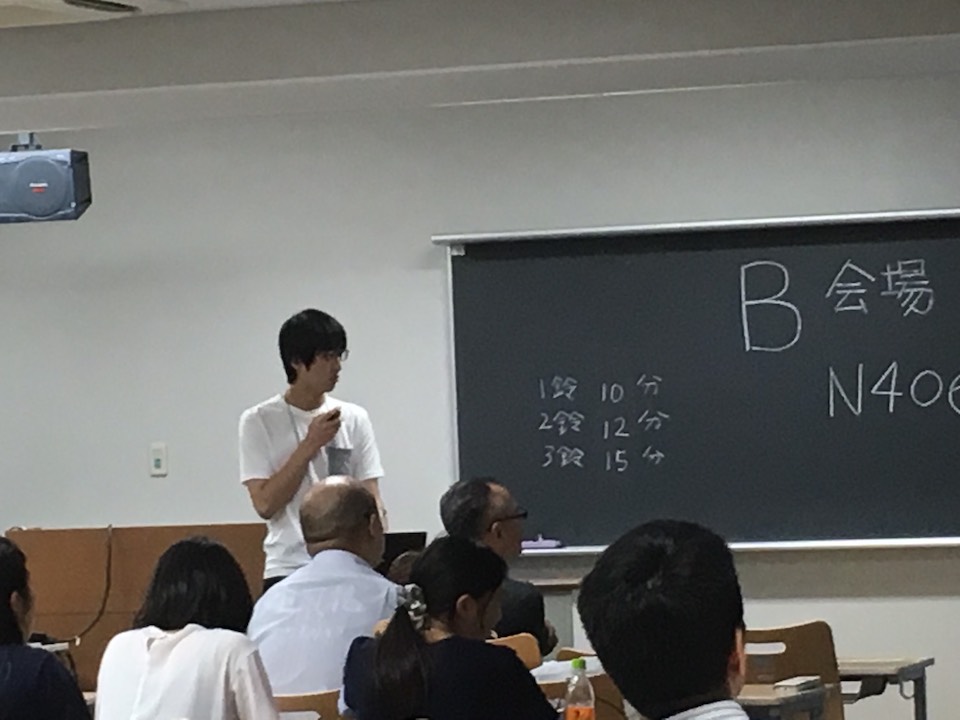Contents
Education
We took part in various events both in and out campus to spread the knowledge of synthetic biology and iGEM to the public.
Komaba Festival
2015 Nov. 21st ,22nd ,23rd
Location: UTokyo, Komaba campus
Komaba Festival: a school festival at UTokyo
We introduced synthetic biology as an academic field, and explained our research result and the prize we received from last year.
Result: We were able to introduce synthetic biology and iGEM to a number of people who did not know about them. 130,000 visitors came to the festival.
[http://www.komabasai.net/66/visitor/ Homepage of Komaba Festival]
[http://www.komabasai.net/66/visitor/event/search/view/?id=215&category=exhibition_science iGEM Page on Komaba Festival]
May Festival
2016 May. 14th, 15th
Location: UTokyo, Hongo Campus
May Festival: a school festival at UTokyo
We introduced synthetic biology as an academic field, and explained our research result and the prize we received from last year, like we did in Komaba Festival. In addition, we invited iGEM teams from other universities in Japan (Kyoto,Gifu,KAIT_Japan,Tokyo-NoKoGen, Tokyo_Tech), and presented respectively.
Result: We were able to introduce synthetic biology and iGEM to a number of people who did not know about them. 145,000 visitors came to the festival.
The poster of iGEM Kyoto and member of Kyoto - Daiya Ohara
Techno Edge
2016 Aug. 9th, 10th
Location: UTokyo, Hongo Campus
Techno Edge: an event for primary and senior school students to experience engineering.
We explained the basic concept of genetic engineering, using simple examples to make every participant, including primary school students, understand.
What’s more, we explained BioBrick, iGEM, and our activities as well.
Result: We were able to deepen participants’ understanding of genetics and molecular biology, since most of them were unfamiliar with heredity, DNA or E. coli, let alone genetic engineering.
The Genetic Society of Japan
2016 Sep. 7th ,8th ,9th ,10th
Location: Department of International Relations, Nihon University, Mishima Campus
The Genetic Society of Japan: an academic meeting which researchers from all over Japan gather to, presenting and listening to each others' research.
Several presenting topics were set in the Genetic Society of Japan, among which we presented as the iGEM team of Japan. Participants include Gifu,Nagahama,Kyoto,Tokyo_Tech,UT-Tokyo,HokkaidoU, and professors from Hokkaido University and Tokyo Institute of Technology.
We made a 15 minutes presentation about our project at Symposium Workshop WS10-6 (18:15-18:30)
Symposium Workshop title:Genetics, Synthetic Biology and iGEM(International Genetically Engineered Machine)Activities by Undergraduate Students
We also listened to words from not only iGEM related people, but also professors in genetics, and received valuable advices.WS10-6 18:15-18:30
We are grateful to iGEM Nagahama for providing such a wonderful opportunity of discussion.(See Nagahama's Page)
Result: We were able to aware many researchers in genetics of iGEM and attract their attentions.
[http://gsj3.jp/taikai/88taikai/index.html The Genetic Society of Japan, 88th Conference]
Crowd Funding
We have been gathering team registration fee through Academist, an academic crowd funding company. The funding is still going on today (2016. Oct. 19th)
Donor will be invited to our presentations and will receive our research report.
Result: We can gather more than 3500 dollars.
We were able to get many access to our page in Academist, thus informing a large number of people of iGEM and our activities.
iGEM UT-Tokyo page on Academist
UTokyo News
Articles on iGEM UT-Tokyo was written on the newspaper of UTokyo.
Result: The recognition of iGEM at UTokyo has been raised, and we were able to appeal our passion for the project to many people.
[http://www.todaishimbun.org/igem20160919/ Article Online]
Environment
An Investigation into the Potential Risks and Limitations of Genetic Kill Switches
In our project, we have designed a programmable genetic system that allows the gene expressed in E. coli to change after every generation. Further applying the system, we can potentially create a genetic system that can kill the host cell after a desired number of divisions. In order to better design our genetic kill switch as well as to be aware of the potential problems of our kill switch applied in the environment, in this section of the human practices, we have investigated and evaluated the potential risk and limitations of genetic kill switches. The detailed design of the kill switch application is described in the applications page.
The principal problem on the release of genetically modified organism (GMO) is associated with the preservation of biodiversity as is mentioned in Cartagena Protocol. This time we designed a programmable genetical system which works on E. coli and can kill the host cell after any times of division. Our project introduces the possibility to consistently solute the problem; utilizing the advantage of genetical modulation with few damage on environment. To put this idea into practice, we must discuss about possible risks on handling GM microorganisms with our kill switch system in natural environment.
There are several lethal gene known to kill E. coli by internal expression. Kill switch utilizes such lethal genes for killing the host cell on desired condition. If E. coli naively express lethal gene without control, it wouldn’t be a useful tool. With our kill switch system, it is possible to ensure sufficient time before expressing lethal gene. For example, we can actuate kill switch after 105 generations by inserting 3-, 5- ,and 7-generational loop system (as 105 is a multiple of 3, 5, and 7). Beneficially, E. coli with such kill systems dies endogenously without any chemical or other external stimuli.
Let’s consider the effect to the environment when we release the GM bacteria, which are triggered kill switches after 105 generations, to decontaminate the environment.
If we release the bacteria to the polluted soil, they would rapidly degrade the pollutant using their
efficient enzymes acquired from genetic engineering. Every cell division means the step to their death. They could neutralize enormous amount of pollutant by the moment when the kill switch is triggered after 105 generations. After that, the kill switch, which have never been expressed, will be expressed and lead the owners to death. In this way, we can make them work for a certain period and then make them commit suicide.
This system has advantages compared to a system, in which kill switch is turned on when a cell stimulated by external factors. To turn on kill switches triggered by a chemical, like arabinose, It is necessary to scatter chemical and let it reach GM microorganism. This is not realistic in natural environment. Scattering a lot of chemical can have bad effect to the environment. In the sea, where added chemicals diffuse quickly, or in the soil, where we cannot add chemicals directly to GM microorganisms, we cannot use chemicals as a trigger of kill switch. On the other hand, using internal trigger system used in our project, we need not to concern about requirements for scattering chemicals or diffusion of GM microorganisms.
Let’s think about possible risks on this method. First, we should consider the case when whole system is work perfectly. Does a difference of division cycle among each cell cause problem or not? If 104 times multiplications take only a little time, it seems not to cause problems. However, how about the case where cell division takes significantly long interval? We think there is not so much problem in this regard. First of all, even if a division interval is long, they must ultimately divide up to all counts, and all cells would be die. Next, we can indicate for two reasons that the existence of cells which are unable to divide couldn’t cause much problem. One reason is that each cell which does not divide into new cells has its lifespan and no choice to death. The other notable reason follows from the fact that GM organisms exert critical influences on environment when they proliferate abundantly. Inversely, it can be said that if GM microorganisms’ cells with our kill system isn’t triggered, or equivalently the cells has very low level of multiplication, they have few impact on environment. Thus, our strategy utilizing a division as a gene expression trigger has fundamental advantage when we have no option other than the distribution of GMO.
Let’s further examine potential defects and environmental risks accompanied with the system.
You might find defects on mechanism of loop system. Each system is probable to stop or skip process undesiary. If the genetical process of our kill system is stopped, GM microorganisms might proliferate without operation of division counting. More worth case is when several units of division counting halt simultaneously; it leads breakdown of whole system.
Also loop system might not start if there is leaky expression from Pbad even under an arabinose free condition. Moreover, the gene mutation can not be overlooked. Even from one cell of E. coli, the final number of cells after 100 multiplications is calculated as 2^100≒10^30. For such a great number of cells, it is no wonder some of these are observed to gain mutation leading to loss of kill switch function.
Another problem might rise from a horizontal gene transfer. Procaryote cell can take in exogeneous DNA from surrounding environment. If a wild strain took in gene derived from modified GMO and that gene was not lethal one, the situation would be regarded as a irreversible release of modified gene.
To solute these problem, there are several method: installing kill switch repeatedly for insurance, using lethal gene which degradates host cell’s genome and plasmid. Despite of plenty choices for safety, any choice is not sufficient for perfect protect. Although our project would be the technical basis for release of GMO, we shouldn’t forget discuss problems carefully.
APP
Overview
To spread the knowledge of synthetic biology, we made an Android game app where E. coli culture and genetic engineering techniques are included.
This project was launched with our co-developer, iGEM Tokyo-Tech. iGEM UT-Tokyo was responsible for the game deign and iGEM Tokyo-Tech for the coding.
E. coli can be increased by tapping the main screen. Also, E. coli increase with time wihout any treatment.
Experience point, which will lead to level up, can be accumulated as E. coli increase. Items, new genes and genetic engineering technique can be gained as the level goes up.
Notice that we have only gone to the point to make E. coli increase. The procedure of genetic engineering will be added in the coming version.
Result
Although our team and Tokyo-Tech had reached an agreement that we develop application together and we decided that Tokyo-Tech work on coding, NO products about it have been given by them (by 20 Oct 2016).









